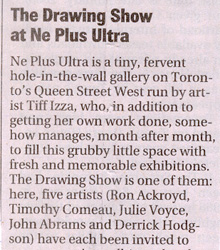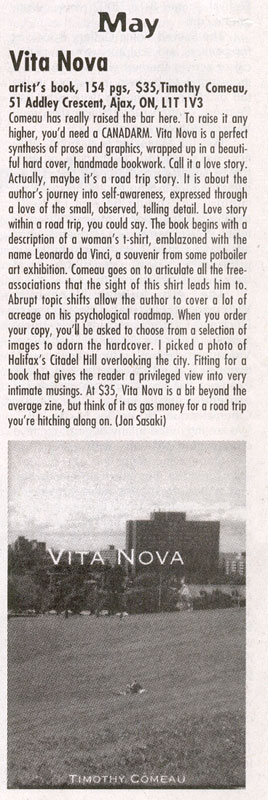Reproduced here with RM’s permission.
Art, like rust, never sleeps
No art is worth leaving the house for in the first week of January.
I mean that.
Were Warhol himself to rise from his Brillo box tomb and offer me a stable of rent boys and a free silk screen portrait, I???d fake a headache. After a solid month of art auctions, holiday art sales, artists??? parties, all the good films Hollywood saves for December, special invitation only viewings, open houses, charity exhibitions, studio sales, and, most tiring, the slack jawed inattentions of Air Canada during the Christmas rush (has Air Canada forgotten that Christmas happens in winter, when it snows, when runways have to be ploughed and wings de-iced, that they are called Air Canada because they???re located in Canada ??? you know, the same country as the Artic?) the last thing I want to do is haul my shortbread padded backside to a gallery.
Next week, I???ll go next week.
For now, there???s the internet. When I first started wandering the internet 7 years ago, I was convinced that, like television, this new medium would be art proof ??? because any entertainment device that simultaneously connects the user to images of naked pregnant ladies eating burritos and a lengthy, heartfelt monograph on the plot possibilities of a love child between Captain Kirk and Fembot, is too democratic, too freewheeling for the art world, which relies on creating an aura of exclusion and inimitability.
Wrong again. Art, like rust, never sleeps.
Several Toronto artists have taken to the internet like ticks to a bare ankle, and us shut ins (with high speed connections) need never do the opening night shuffle-and-grin again. Among the best of the lot are those artists who use their sites to promote not only their own creations but to direct the visitor???s attention to other on-line resources, many of which, inevitably, link the visitor to even more sites. As the poet Lynn Crosbie once noted, surfing the internet is like picking an endless scab ??? a gratifying, compulsive, and joyously counterproductive experience (like the best art). The plethora of online art sites coming out of Toronto are gradually building a local and international gallery that never ends ?? a frequent nightmare of mine, granted, but you can always turn the computer off.
Multimedia artist Sally McKay???s website is easily the most informative and lively of the lot. Packed with links to everything from cyclist advocacy sites to other artist???s diatribes, as well as McKay???s own sparkling animations and photography, the site has more going on in it than most traditional print art magazines.
McKay???s seemingly limitless curiousity means that the viewer will be treated to ruminations on quantum physics??? latest fad, string theory, a brief essay on the fate of Luna/Tsux???iit (the BC-based whale determined to hang out with his human friends), and a randomly collected assortment of art show Top Tens for 2004 submitted by readers ??? all decorated with McKay???s images of DNA strands, animated particles, wacky models of the earth, and a sad but sweet set of photos of bizarre gadgets found in a Radio Shack catalogue. Beats flipping through Fuse or Art Forum.
The granddaddy of Toronto art sites is Year Zero One, an online gallery specializing in art made specifically for the internet. Headed by artist Michael Alstad, Year Zero One has been showcasing web art since 1999 ??? in fact, it helped create the movement. Recent projects include an exhibition staged in a taxicab (with interactive art triggered by GPS transmissions presented on a screen in the cab), a forum on new media art sponsored by the Banff Centre, and teleconferences on a ???microprocessor platform??? called Art Interface Device (don???t ask me to explain, ask Alstad).
If some, or all, of this sounds too much like reading your laptop owner???s manual, don???t worry. One of the guiding principles of Year Zero One is accessibility, making new media comprehensible to both practicioners and audiences. My only critique is, as a fan of Alstad???s provocative multimedia installations, there is not more of the head honcho???s art on display.
Pete Dako, on the other hand, is decidedly not shy about sharing his work with the world. His personal website offers free samples of his own videos, songs, and idiosyncratic, comics-driven art, as well as more ramblings about culture and politics than you may be able to get through in one visit.
What, I asked Dako (via email, of course) prompts him to put so much free art on his site, to create his own personal museum, when he needs, like any artist, to sell his work?
“Mainly because it’s fun! The web is a kind of on-going conversation about everything. The only drawback is that the audience has to be mildly techno-savvy or equipped to make the site work, which is not a problem in a gallery, where you can just walk in.”
And, Dako reminds me, buyers do purchase art off the web, just like clothes or groceries. If anything, he argues, having a never-ending exhibition on line means that his potential sales are not limited to a month long run in a stationary gallery.
Limitless access is also the key to painter Timothy Comeau???s on line project Goodreads. Like Readers??? Digest (without the stories of miraculous rescues by dogs or profiles of sitcom stars), Goodreads sorts through the enormous amount of culture and politics essays on line and sends the subscriber (at no charge) links to what Comeau considers the best. And he has excellent taste.
In any given week, expect dozens of articles about, for instance, voter fraud in the recent American election, the rhetorical problems inherent in trying to give a name to the first years of this century (the zeros? the O???s?), and current developments in mathematical theory. Phew!
While the majority of Comeau???s varied selections link the reader to the latest – and often choicest – bits of unintentionally hilarious art world sniping and counter bitching, Goodreads is not, oh happy day, another incestuous art world bulletin board. Rather, it???s more like a clipping service for anyone with an interest in art making, the social sciences, or the downright weird.
When, I wonder, does Comeau sleep?
www3.sympatico.ca/petedako
www.digitalmediatree.com/sallymckay
www.year01.com
www.goodreads.ca





